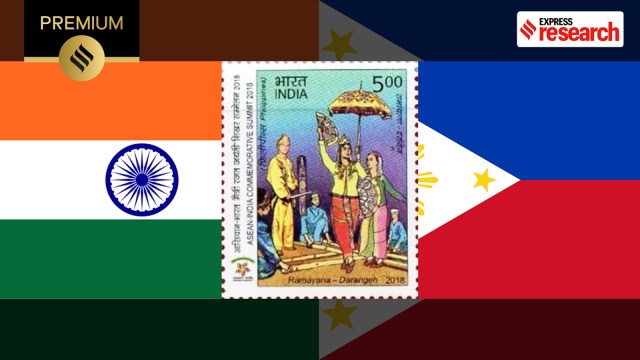Ports, polities, and partnerships: The history of India-Philippines ties
Amidst the recent camaraderie between the governments of India and the Philippines, a look at the cultural and maritime history that ties the two polities
 (Edited by Abhishek Mitra)
(Edited by Abhishek Mitra)Given the recent camaraderie between the governments of India and the Philippines, a short history of their ties is in order. A cautious long-term approach suggests that there are four kinds of historical evidence — inscriptions and chronicles, archaeological findings, texts and performing genres, and secondary historiographical syntheses — that inform the historiography in question. Romantic narratives of civilisational unity between the two polities are exaggerated. However, there are concrete grounds to observe how India and the Philippines are natural partners on the cultural and maritime frontiers.
Chola expeditions and India’s maritime circuit
The 11th-century Chola naval operations remain a touchstone for debates on South Asian history and ancient India’s maritime expanse. According to Tamil inscriptions, Chola naval campaigns struck at ports of the Srivijaya Empire (Sumatra and parts of the Malay Archipelago). The Tirukkadaiyur inscription and related archaeological materials convey ships, gates, and booty as measures of Chola success in Southeast Asia. Historians of Southeast Asian maritime polities tell us that political sovereignty in the region was often thalassocratic — organised around ports rather than contiguous land empires. Historian Hermann Kulke emphasises Srivijaya’s role as a maritime mandala that mediated Indian cultural forms to islands further east.
India’s Southeast Asian influence cannot be articulated without recapitulating the journeys of a diaspora of Indo-Southeast Asian merchants and priestly travellers who transmitted Sanskrit vocabulary and ritual artefacts into the Malay Archipelago. Seen thus, the Chola expedition was a chapter in a much longer history of maritime diplomacy and cultural exchanges between India and Southeast Asia. Meanwhile, India’s Coromandel ports became integrated into an eastern Indian Ocean circuit that reached the Strait of Malacca. Subsequently, this undergirded exchanges with the Philippines. This circuit, for understandable reasons, is of special interest to history enthusiasts. This is particularly true for those with a fancy for a Greater-India-narrative. However, it needs to be framed within a broader maritime zeitgeist that unfolded around maritime Srivijaya (the 7th-13th-century Indonesian Empire) and Majapahit (the 13th-early-16th-century Hindu-Buddhist Javanese Empire). A deeper understanding of India’s long-distance contacts with Southeast Asia can help achieve far greater, sophisticated cultural cooperation under India’s Act East policy.
The Philippines’ ostensible lack of monumental Hindu-Buddhist temple complexes — which are otherwise conspicuous in Cambodia, Indonesia, Vietnam, Laos, Malaysia, and Thailand — leads one to often underestimate Indianate ties to the Philippine archipelago. According to Filipino scholar Joefe B. Santarita, India-Philippines contacts are embodied in smaller, more mobile cultural forms, like texts, dance forms, vocabulary, and portable artefacts. Intangible (fables, dances, lexicon) and tangible (icons, pendants, stamps, beads) relics from this heritage constitute a composite index of precolonial India-Philippines connectivity.
Maharadia Lawana and other variants
On the textual and performative side, there is the indomitable Maharadia Lawana, the Maranao variant of the Ramayana canon of epics found in Southeast Asia. As the Filipino linguist Juan R. Francisco’s fieldwork has shown, Maharadia Lawana condenses the Ramayana into a sequence of episodes that correspond roughly to canonical kandas (Balakanda, Aranyakanda, Kiskindhakanda, Sundarakanda and Yuddakanda). The core narrative frames of the Ramayana still survive in Filipino cultural memory, except for original locations and subtexts that metamorphose in the light of local habitats, altered episodes, and historically distinct moral emphases.
Scholars agree that the Filipino Maharadia Lawana is an indigenised Ramayana mutant of the original Indian epic authored by sage Valmiki, absorbed through Malay-Javanese channels rather than Indian cultural supremacy over the island nation. The Darangen of the Maranao is a Filipino archive of epic memory that complements Maharadia Lawana. The Darangen is an extensive oral epic — some 25 narrative chapters — whose principal hero, Bantugen, and episodes such as ‘The Abduction of Princes Lawanen’ mirror structural motifs of the Ramayana, interweaving tropes of martial romance, supernatural agencies, and localised cosmologies, with accretions from Islamic elements layered onto a pre-Islamic core. The Darangen is not merely a repository of remote memory but a lived moral archive, whose codification is recited in households, and whose episodes shape communal ideals and social conduct, further demonstrating how Philippine epic adaptations conserve Indianate narrative and performative structures within local idioms.
The Filipino theatre tradition has repeatedly drawn on Maharadia Lawana and related materials, and modern productions and adaptations use these narratives to explore identity and history under changing political conditions. Performance and community rituals thus act as living archives of shared narrative structures and social memory shared between the two sovereign nation-states.
Similarly, another vector of cultural transmission — dance performances — is seen in the Maranao Singkil dance. The dance form’s choreographic grammar — the step patterns across crossed bamboo poles, the role of the principal dancer (Princess Gandingan), the parasol and the accompanying gong and kulintang ensemble — reflect a larger Southeast Asian performance repertoire with formal affinities to Indian dance traditions. Interestingly, a comparative study of Orissan art underscores the point that there are formal affinities in sculptural motifs, bead-types, and other small finds that travel with merchants and pilgrims from Kalinga/Orissa into Malay and Indonesian contexts. These correspondences make it plausible that similar material currents reached the Philippine islands through intermediary ports. This does not itself suggest a literal borrowing of styles of Indian dance forms; rather, the bodily gestures, hand positions, and embodied narrative techniques of Singkil point to enduring stylistic diffusions caused by Srivijayan and Majapahit cultural circulations.
There is also a wealth of Sanskrit loanwords across Philippine languages — almost 340 Sanskrit-derived items exist in Philippine vocabularies, about half of which have demonstrable Sanskrit provenance. Examples of this include guro (teacher), saksi (witness), and dukha (sorrow), which have been handed down through sustained lexical transmission across centuries, typically dating to a period between the tenth and fifteenth centuries, mediated through Malay and Javanese intermediaries who had links with the Coromandel coast.
Besides these, there are portable objects discovered from the Philippines whose typology and historical contexts point to Indianate circuits. The Agusan gold ‘Vajralasya’ Tara (found in the Agusan River and now in the Field Museum, Chicago), a clay votive stamp from Calatagan depicting Avalokitesvara/Padmapani in tribhanga pose (14th-15th c.), the Golden Garuda pendant from Palawan (linked stylistically to the Majapahit corpus), and a variety of Indo-Pacific trade beads find worthy mentions in this list. These material nodes confirm maritime networks linking the Philippine littoral to eastern Indian Ocean commerce through Indonesian and Malayan merchants. Imported images, beads and textiles served as prestige objects in precolonial Philippine polities, circulating in elite gift networks and funerary contexts to acquire social values transcending mere commerce. So, instead of material legacies being enshrined as temple complexes, Indo-Philippine cultural transactions were embodied as portable, high-value objects in elite contexts. This signals a difference in the political ecology of the Indo-Philippine heritage within the larger heritage of Indo-Southeast Asian cultural memories, but surely not the cultural isolation of this trajectory of transactions.
Towards a Chola network
There is a strong practical counterpart to this historical context. As contemporary Filipino scholars like Santarita believe, Indian culture may not have been the sole driver of the modernisation in the transition of Southeast Asian chiefdoms to kingdoms, but Indian notions of kingship and allied cultural beliefs and rituals influenced the metamorphosis of chiefs into rajas and maharajas in the Malay Archipelago — even in precolonial Philippines. Since India-Philippines historic ties are empirically accessible, the prospect of institutions to reactivate bilateral cultural legacies is unignorable. Considering that discoveries of India-Philippines transactions are portable and perishable — instead of being monumental temple complexes — these dispersed traces all the more need conversion into durable institutional ties. Collaborative maritime-archaeology programmes between Indian and Philippine institutions can better preserve discoveries (like beads and ceramics found in the Bay of Bengal-Malacca Straits axis) and test hypotheses about their circulation and chronology, drawing from experts in this area. Objects such as the Agusan Tara or the Calatagan stamp can become pedagogic tools for exhibitions with layered histories of mediation by Malay and Javanese intermediaries. The Filipino critic and cultural commentator, Nicanor G. Tiongson, hints at the possibility of comparative philological projects to document continuities and divergences between Singkil, Darangen, and South Indian linguistic, narrative, and dance repertoires. As he adds, Lord Ram’s “quest for enlightened leadership is the region’s quest for enlightened nationhood.” Meanwhile, historian Daniel G.E. Hall’s reminder about Southeast Asian historical autonomy is salutary here, in that Indo-Southeast Asian contacts did not necessarily equal political subordination, and local agencies always had the autonomy to negotiate with incoming elements.
Nonetheless, a provisional frame labelled the ‘Chola Network’ can be useful — provided it is used carefully as a heuristic rather than as a celebratory genealogy. The phrase captures important structural features documented in the sources: coastal polity-formation and sustained littoral orientation on the Coromandel and Andhra-Kalinga tracts, episodic projection of naval force and symbolic ritual, resident Tamil mercantile diasporas attested in inscriptions, and a Srivijayan thalassocratic matrix that mediated cultural flows across the Straits of Malacca. In practice, the ‘Chola Network’ might serve as a policy metaphor to frame institution-building along historically plausible lines, if cautiously embedded in peer-reviewed research, transparent pedagogy, and multilateral frameworks.
References
Chakravarti, R. (2011, January). Sectional President’s Address: The Pull Towards the Coast: Politics and Polity in India (C. 600-1300 CE). In Proceedings of the Indian History Congress (Vol. 72, pp. 22-42). Indian History Congress.
Christie, J.W. (1998). The medieval Tamil-language inscriptions in Southeast Asia and China. Journal of Southeast Asian Studies, 29(2), 239-268.
Fernandez, D.G. (1995). The playbill after 1983: Philippine theatre after Martial Law. Asian Theatre Journal, 12(1), 104-118.
Francisco, J.R. (1989). The Indigenization of the Rama Story in the Philippines. Philippine studies, 101-111.
Ghosh, A. (1992, January). The Gangetic Campaign by the Cholas (11th Century). In Proceedings of the Indian History Congress (Vol. 53, pp. 79-86). Indian History Congress.
Hall, D.G.E. (1973). The integrity of Southeast Asian history. Journal of Southeast Asian Studies, 4(2), 159-168.
Herujiyanto, L.H.N. (2024, January). Maharadia Lawana: The Indigenous Filipino ‘Ramayana’ by Way of Diaspora and. In Proceedings of the Critical Island Studies 2023 Conference (CISC 2023) (Vol. 818, p. 33-39). Springer Nature.
Kulke, H. (2016). Śrīvijaya Revisited: Reflections on State Formation of a Southeast Asian Thalassocracy. Bulletin de l’Ecole française d’Extrême-Orient, 102, 45-96.
Mishra, P.P. (2000, January). Orissan Art in Island Southeast Asia: A Case Study of Cultural Interaction. In Proceedings of the Indian History Congress (Vol. 61, pp. 1062-1070). Indian History Congress.
Saber, M. (1961). Darangen: The epic of the Maranaws. Philippine Sociological Review, 9(1/2), 42-46.
Santarita, J. B. (2018). Panyupayana: The emergence of hindu polities in the pre-islamic Philippines. In Shyam Saran (ed.), Cultural and civilisational links between India and Southeast Asia: Historical and contemporary dimensions (pp. 93-105). Singapore: Springer.
Santarita, J. B. (2023). Enhancing India-Philippines Cooperation in Culture. Act East: Asean-India Shared Cultural Heritage. New Delhi: Research and information System for Developing Countries, 209-222.
Spencer, G. W. (1976). The politics of plunder: The Cholas in eleventh-century Ceylon. The Journal of Asian Studies, 35(3), 405-419.
Tiongson, N.G. (2019). Transforming Tradition in the Dance Drama Realizing Rama, 1997-2004: Documenting the Process of ‘Inter-Creation’ in an ASEAN Production. Perspectives in the Arts and Humanities Asia, 9(2), 3-28.
- 01
- 02
- 03
- 04
- 05































